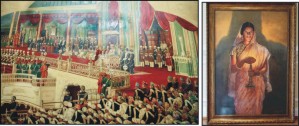Jaganmohan Palace is one of the Palaces located in Mysore city. The Palace was constructed by Krishnaraja Wadiyar III in 1861 and was the home for the Royal family after the Mysore Palace was burnt down in a fire accident. It has now been converted into an art gallery and a function hall. The Palace is one of the seven Palaces of the Royal City of Mysore and one of the most beautiful contributions of the Wadiyars to the City.
The huge pavilion in front of the Palace was used for holding meetings of the Representative Assembly and the Convocations of the University of Mysore. The installation of Krishnaraja Wadiyar IV took place in this pavilion in 1902 and was attended by Lord Curzon, the then Viceroy and Governor General of India. The Art Gallery houses the prestigious collection of paintings of Raja Ravi Varma, a great artist of Thiruvananthapuram, who had carried out an assignment for Maharaja Krishnaraja Wadiyar IV in 1904.
In 1915, the Palace was converted into an art gallery, which was later renamed in 1955 in the name of Jayachamarajendra Wadiyar, as the Sri Jayachamarajendra Art Gallery. Jayachamarajendra Wadiyar converted the Palace into a trust and opened it for public viewing.
The Palace is built in traditional Hindu style and has three stories. In 1900, an external facade with a hall behind it was added to the Palace. This facade has three entrances and the entablature has religious motifs and miniature temples crafted on it. The walls of the interiors are painted with murals. These mural paintings which follow the traditional style of the Mysore School of painting depict the Dasara scene and the canvas depicting the sequence of the Jumbo Savari stretches across three walls. This mural is the earliest known picture of the Mysore Dasara and has been painted using vegetable dyes. A family tree of the Wadiyars tracing the lineage of the royal family is also painted on a wall. Two wooden displaying Dashavatara, the ten incarnations of Lord Vishnu is also present in the Palace.
The art gallery contains one of the largest collection of artefacts in South India. Most of these artefacts are paintings, prominent among which are those by Raja Ravi Varma, some of which demonstrate scenes from the Hindu epics, Ramayana and Mahabharata. The collection of paintings in the gallery exceed 2000 in number and these belong to different Indian styles of painting like Mysore, Mughal and Shantiniketan. 16 paintings of Raja Ravi Varma were donated to the gallery by Jayachamarajendra Wadiyar. Another important painting present here is the ‘Lady with the Lamp’ which was painted by the artist Haldenkar and is placed in a dark room where it is the only exhibit. This is to give an illusion that the glow of the lamp is illuminating the face of the woman. Some other painters whose works are exhibited here include Nikolai Roerich, Svetoslav Roerich and Rabindranath Tagore. Other exhibits here include weapons of war, musical instruments, sculptures, brass-ware, antiques coins and currencies. Some other uni
que artefacts exhibited here is a French Clock which has a mechanism in which a parade by miniature soldiers is displayed every hour; beating drums mark the seconds and a bugle marks the minute. Paintings made on a grain of rice which can be viewed only through a magnifier are also displayed here.
Jayachamarajendra Art Gallery has collection of several Indian artists and Western artists as well. While, the paintings of Raja Ravi Verma is a delight to art connoisseurs there are also few paintings from western artistes which comes a huge surprise for the visitors.
‘Crucifixion’ by P.P. Rubens and miniature paintings by L.Gunov introduces visitors to the western paintings. The art gallery also houses many Mysore Style Paintings that are visual treat to watch.
A new hall was built in 2003 because there was insufficient space available to exhibit all the paintings. The original paintings of Raja Ravi Varma which are over 100 years old were restored by the Regional Conservation Laboratory (RCL). Syrendri, Victory of Meganath and Malabar Lady were some of the paintings of Ravi Varma that were restored. Even the murals on the walls had been damaged because of water seepage and these were also restored by RCL. The auditorium of Jaganmohan Mohan Palace is also used by organisations for the conducting cultural programmes.
The Jaganmohan Palace is being maintained by Sri Jayachamarajendra Art Gallery Trust which has been working continuously to maintaining the building as well as the artefacts. —VNS
source: http://www.starofmysore.com / Star of Mysore / Home> General News / August 16th, 2014
